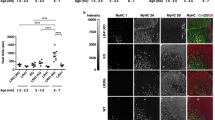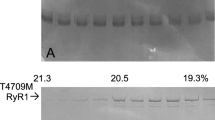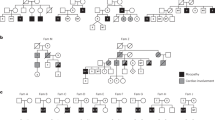Abstract
MYOTONIA (stiffness and impaired relaxation of skeletal muscle) is a symptom of several diseases caused by repetitive firing of action potentials in muscle membranes1. Purely myotonic human diseases are dominant myotonia congenita (Thomsen) and recessive generalized myotonia (Becker), whereas myotonic dystrophy is a systemic disease. Muscle hyperexcitability was attributed to defects in sodium channels2,3 and/or to a decrease in chloride conductance (in Becker's myotonia4 and in genetic animal models5–10). Experimental blockage of Cl− conductance (normally 70–85% of resting conductance in muscle11) in fact elicits myotonia1,9. ADR (ref. 12) mice are a realistic animal model5–7,12–18 for recessive autosomal myotonia. In addition to Cl− conductance5, many other parameters6,12,16 are changed in muscles of homozygous animals. We have now cloned the major mammalian skeletal muscle chloride channel (C1C-1)19. Here wereport that in ADR mice a transposon of the ETn family20–23 has inserted into the corresponding gene, destroying its coding potential for several membrane-spanning domains. Together with the lack of recombination between the Clc-1 gene and the adr locus, this strongly suggests a lack of functional chloride channels as the primary cause of mouse myotonia.
This is a preview of subscription content, access via your institution
Access options
Subscribe to this journal
Receive 51 print issues and online access
$199.00 per year
only $3.90 per issue
Buy this article
- Purchase on Springer Link
- Instant access to full article PDF
Prices may be subject to local taxes which are calculated during checkout
Similar content being viewed by others
References
Rüdel, R. & Lehmann-Horn, F. Physiol. Rev. 65, 310–356 (1985).
Iaizzo, P. A. et al. Neuromusc. Disord. 1, 47–53 (1991).
Franke, C. et al. Muscle Nerve 14, 762–770 (1991).
Rüdel, R., Ricker, K. & Lehmann-Horn, F. Muscle Nerve 11, 202–211 (1988).
Mehrke, G., Brinkmeier, H., & Jockusch, H. Muscle Nerve 11, 440–446 (1988).
Jockusch, H. in The Dynamic State of Muscle Fibers (ed. Pette, D.) 429–443 (Walter de Gruyter, New York, 1990).
Rüdel, R. Trends Neurosci. 13, 1–3 (1990).
Lipicky, R. J. & Bryant, S. H. J. gen. Physiol. 50, 89–111 (1966).
Bryant, S. H. & Morales-Aguilera, A. J. Physiol., Lond. 219, 367–383 (1971).
Adrian, R. H. & Bryant, S. H. J. Physiol., Lond. 240, 505–515 (1974).
Bretag, A. H. Physiol. Rev. 67, 618–724 (1987).
Watkins, W. J. & Watt, D. C. Lab. Anim. 18, 1–6 (1984).
Reininghaus, J., Füchtbauer, E.-M., Bertram, K. & Jockusch, H. Muscle Nerve 11, 433–439 (1988).
Füchtbauer, E.-M., Reininghaus, J. & Jocksuch, H. Proc. natn. Acad. Sci. U.S.A. 85, 3880–3884 (1988).
Brinkmeier, H. & Jockusch, H. Biochem. biophys. Res. Commun. 148, 1383–1389 (1987).
Jockusch, H., Reininghaus, J., Stuhlfauth, I. & Zippel, M. Eur. J. Biochem. 171, 101–105 (1988).
Költgen, D., Brinkmeier, H. & Jockusch, H. Muscle Nerve 14, 775–780 (1991).
Jockusch, H., Schenk, S. & Gronemeier, M. Mouse Genome 86, 216 (1990).
Steinmeyer, K., Ortland, C. & Jentsch, T. J. Nature 354, 301–304 (1991).
Brûlet, P., Kaghad, M., Xu, Y.-S., Croissant, O. & Jacob, F. Proc. natn. Acad. Sci. U.S.A. 80, 5641–5645 (1983).
Brûlet, P., Condamine, H. & Jacob, F. Proc. natn. Acad. Sci. U.S.A. 82, 2054–2058 (1985).
Sonigo, P. et al. Proc. natn. Acad. Sci. U.S.A. 84, 3768–3771 (1987).
Shell, B., Szurek, P. & Dunnick, W. Molec. cell. Biol. 7, 1364–1370 (1987).
Heller, A. H., Eicher, E. M., Hallett, M. & Sidman, R. L. J. Neurosci. 2, 924–933 (1982).
Neumann, P. & Weber, T. Mouse News Lett. 83, 157 (1989).
Jentsch, T. J., Steinmeyer, K. & Schwarz, G. Nature 348, 510–514 (1990).
Conte Camerino, D., De Luca, A., Mambrini, M. & Vrbovà, G. Pflügers Arch. 413, 568–570 (1989).
Lipicky, R. J., Bryant S. H. & Salmon, J. H. J. clin. Invest. 50, 2091–2103 (1971).
Friedmann, J. M., Leibel, R. L. & Bahary, N. Mammalian Genome 1, 130–144 (1991).
Meyers, J. C. et al. Proc. natn. Acad. Sci. U.S.A. 78, 3516–3520 (1981).
Dean, M. et al. Nature 318, 385–388 (1985).
Quinto, C. et al. Proc. natn. Acad. Sci. U.S.A. 79, 31–35 (1982).
Yanagi, Y. et al. Nature 308, 145–149 (1984).
Bucan, M. et al. EMBO J. 5, 2899–2905 (1986).
Wilkie, T. M. & Palmiter, R. D. Molec cell. Biol. 7, 1646–1655 (1987).
Author information
Authors and Affiliations
Rights and permissions
About this article
Cite this article
Steinmeyer, K., Klocke, R., Ortland, C. et al. Inactivation of muscle chloride channel by transposon insertion in myotonic mice. Nature 354, 304–308 (1991). https://doi.org/10.1038/354304a0
Received:
Accepted:
Issue Date:
DOI: https://doi.org/10.1038/354304a0
This article is cited by
-
Association of Three Different Mutations in the CLCN1 Gene Modulating the Phenotype in a Consanguineous Family with Myotonia Congenita
Journal of Molecular Neuroscience (2021)
-
Skeletal muscle ClC-1 chloride channels in health and diseases
Pflügers Archiv - European Journal of Physiology (2020)
-
Preclinical pharmacological in vitro investigations on low chloride conductance myotonia: effects of potassium regulation
Pflügers Archiv - European Journal of Physiology (2020)
-
Helix O modulates voltage dependency of CLC-1
Pflügers Archiv - European Journal of Physiology (2017)
-
Identification and characterization of the zebrafish ClC-2 chloride channel orthologs
Pflügers Archiv - European Journal of Physiology (2015)
Comments
By submitting a comment you agree to abide by our Terms and Community Guidelines. If you find something abusive or that does not comply with our terms or guidelines please flag it as inappropriate.



